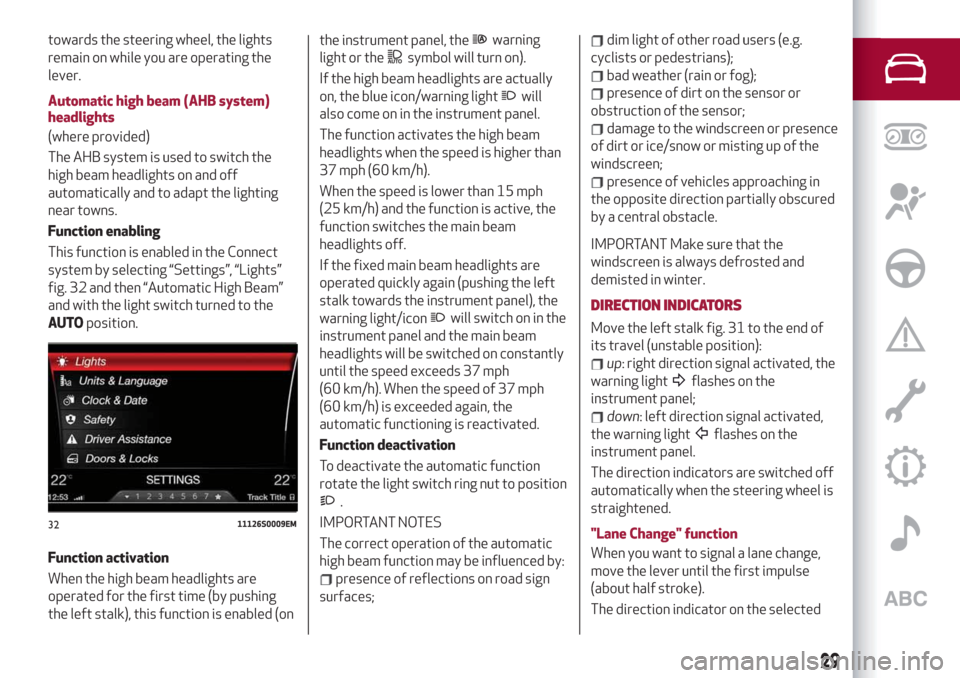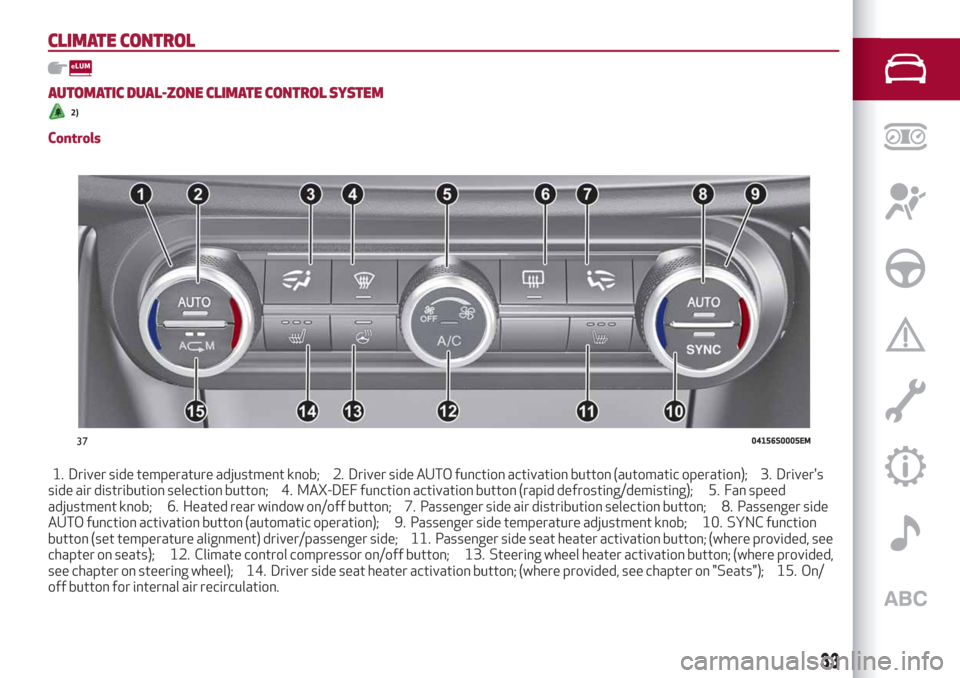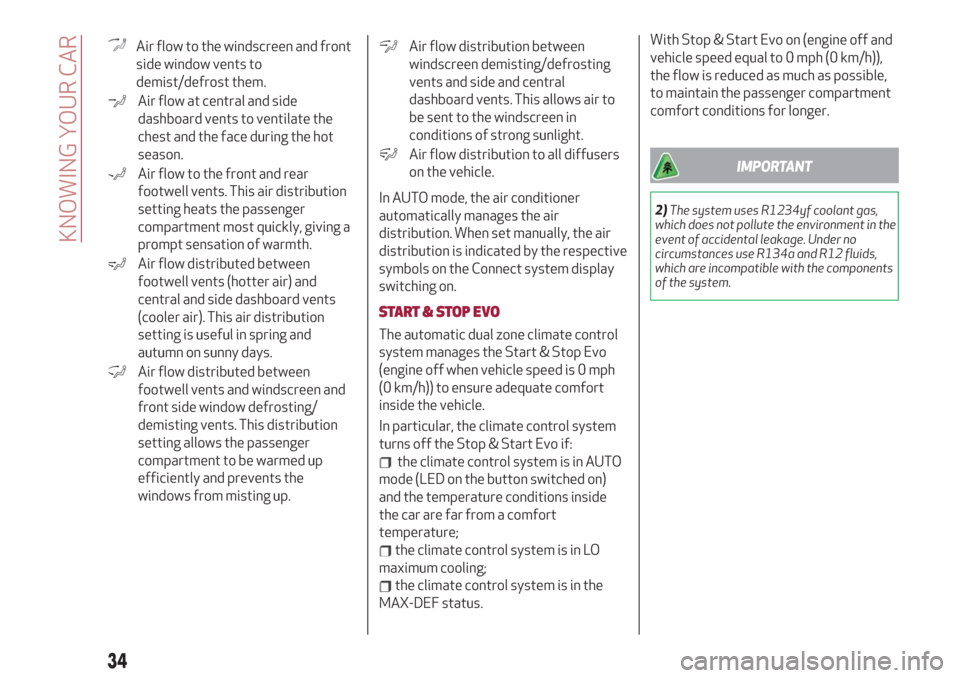Defrost Alfa Romeo Giulia 2019 Owner's Manual
[x] Cancel search | Manufacturer: ALFA ROMEO, Model Year: 2019, Model line: Giulia, Model: Alfa Romeo Giulia 2019Pages: 232, PDF Size: 4.87 MB
Page 31 of 232

towards the steering wheel, the lights
remain on while you are operating the
lever.
Automatic high beam (AHB system)
headlights
(where provided)
The AHB system is used to switch the
high beam headlights on and off
automatically and to adapt the lighting
near towns.
Function enabling
This function is enabled in the Connect
system by selecting “Settings”, “Lights”
fig. 32 and then “Automatic High Beam”
and with the light switch turned to the
AUTOposition.
Function activation
When the high beam headlights are
operated for the first time (by pushing
the left stalk), this function is enabled (onthe instrument panel, thewarning
light or the
symbol will turn on).
If the high beam headlights are actually
on, the blue icon/warning light
will
also come on in the instrument panel.
The function activates the high beam
headlights when the speed is higher than
37 mph (60 km/h).
When the speed is lower than 15 mph
(25 km/h) and the function is active, the
function switches the main beam
headlights off.
If the fixed main beam headlights are
operated quickly again (pushing the left
stalk towards the instrument panel), the
warning light/icon
will switch on in the
instrument panel and the main beam
headlights will be switched on constantly
until the speed exceeds 37 mph
(60 km/h). When the speed of 37 mph
(60 km/h) is exceeded again, the
automatic functioning is reactivated.
Function deactivation
To deactivate the automatic function
rotate the light switch ring nut to position
.
IMPORTANT NOTES
The correct operation of the automatic
high beam function may be influenced by:
presence of reflections on road sign
surfaces;
dim light of other road users (e.g.
cyclists or pedestrians);
bad weather (rain or fog);
presence of dirt on the sensor or
obstruction of the sensor;
damage to the windscreen or presence
of dirt or ice/snow or misting up of the
windscreen;
presence of vehicles approaching in
the opposite direction partially obscured
by a central obstacle.
IMPORTANT Make sure that the
windscreen is always defrosted and
demisted in winter.
DIRECTION INDICATORS
Move the left stalk fig. 31 to the end of
its travel (unstable position):
up: right direction signal activated, the
warning light
flashes on the
instrument panel;
down: left direction signal activated,
the warning light
flashes on the
instrument panel.
The direction indicators are switched off
automatically when the steering wheel is
straightened.
"Lane Change" function
When you want to signal a lane change,
move the lever until the first impulse
(about half stroke).
The direction indicator on the selected
3211126S0009EM
29
Page 35 of 232

CLIMATE CONTROL
AUTOMATIC DUAL-ZONE CLIMATE CONTROLSYSTEM
2)
Controls
1. Driver side temperature adjustment knob; 2. Driver side AUTO function activation button (automatic operation); 3. Driver's
side air distribution selection button; 4. MAX-DEF function activation button (rapid defrosting/demisting); 5. Fan speed
adjustment knob; 6. Heated rear window on/off button; 7. Passenger side air distribution selection button; 8. Passenger side
AUTO function activation button (automatic operation); 9. Passenger side temperature adjustment knob; 10. SYNC function
button (set temperature alignment) driver/passenger side; 11. Passenger side seat heater activation button; (where provided, see
chapter on seats); 12. Climate control compressor on/off button; 13. Steering wheel heater activation button; (where provided,
see chapter on steering wheel); 14. Driver side seat heater activation button; (where provided, see chapter on "Seats"); 15. On/
off button for internal air recirculation.
3704156S0005EM
33
Page 36 of 232

Air flow to the windscreen and front
side window vents to
demist/defrost them.
Air flow at central and side
dashboard vents to ventilate the
chest and the face during the hot
season.
Air flow to the front and rear
footwell vents. This air distribution
setting heats the passenger
compartment most quickly, giving a
prompt sensation of warmth.
Air flow distributed between
footwell vents (hotter air) and
central and side dashboard vents
(cooler air). This air distribution
setting is useful in spring and
autumn on sunny days.
Air flow distributed between
footwell vents and windscreen and
front side window defrosting/
demisting vents. This distribution
setting allows the passenger
compartment to be warmed up
efficiently and prevents the
windows from misting up.
Air flow distribution between
windscreen demisting/defrosting
vents and side and central
dashboard vents. This allows air to
be sent to the windscreen in
conditions of strong sunlight.
Air flow distribution to all diffusers
on the vehicle.
In AUTO mode, the air conditioner
automatically manages the air
distribution. When set manually, the air
distribution is indicated by the respective
symbols on the Connect system display
switching on.
START & STOP EVO
The automatic dual zone climate control
system manages the Start & Stop Evo
(engine off when vehicle speed is 0 mph
(0 km/h)) to ensure adequate comfort
inside the vehicle.
In particular, the climate control system
turns off the Stop & Start Evo if:
the climate control system is in AUTO
mode (LED on the button switched on)
and the temperature conditions inside
the car are far from a comfort
temperature;
the climate control system is in LO
maximum cooling;
the climate control system is in the
MAX-DEF status.With Stop & Start Evo on (engine off and
vehicle speed equal to 0 mph (0 km/h)),
the flow is reduced as much as possible,
to maintain the passenger compartment
comfort conditions for longer.
IMPORTANT
2)The system uses R1234yf coolant gas,
which does not pollute the environment in the
event of accidental leakage. Under no
circumstances use R134a and R12 fluids,
which are incompatible with the components
of the system.
34
KNOWING YOUR CAR